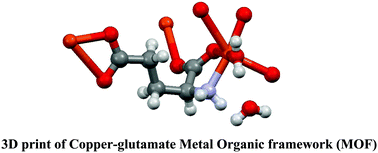Synthesis, characterization and crystal structure of a copper-glutamate metal organic framework (MOF) and its adsorptive removal of ciprofloxacin drug from aqueous solution†
Abstract
Therapeutic drugs are an essential and indispensable element for life. Worldwide, antibiotics are widely used for therapeutic and prophylactic purposes in human and veterinary medicine. Consequently, they are persistently released into the environment as waste water from farm, hospital, domestic and industrial effluents. Research has proved the discharge and presence of therapeutic drugs in wastewater treatment plants, rivers and lakes. Adsorption techniques are widely used for the removal of waste water pollutants due to easy operation, efficiency and the environmentally friendly nature of the technique. A [Cu(Glu)2 (H2O2)]·H2O MOF adsorbent was synthesized by the reaction of Cu2+ with glutamic acid under mixing at room temperature in a ½ : 1 molar ratio. Characterization of the compound was carried out by elemental analysis, IR and UV-Vis spec, SEM and PXRD. The crystal structure is orthorhombic with a space group of P212121. a = 7.2036(5) Å. b = 10.2696(7) Å. c = 11.0023(8) Å. Z = 4. The coordination about the copper is octahedral (6-coordinate geometry), involving four oxygen atoms from the glutamic acid and one nitrogen from the amine of the glutamate. One lattice water molecule is linked directly to the copper central metal in a terminal fashion and a lattice water molecule is found outside the coordination sphere. IR and UV-Vis spectra support coordination of the metal with the ligand. SEM shows clearly that the compound is porous for adsorption. The MOF was studied for the adsorption of aqueous ciprofloxacin drug. Sorption data were subjected to adsorption isotherms and kinetics. The adsorption isotherm data can be best described by the Temkin isotherm, and this revealed the ability of the [Cu(Glu)2(H2O)]·H2O MOF to adsorb 61.35 mg of ciprofloxacin drug per gram of copper glutamate at 25 °C, pH 4.0. The Freundlich sorption intensity supports multiple binding sites of the MOF. The kinetics of ciprofloxacin adsorption follows a pseudo-second-order kinetic model, signifying the presence of physi-sorption. The results suggested the use of [Cu(Glu)2(H2O)]·H2O MOF as an adsorbent for the removal of ciprofloxacin from aqueous solution.



 Please wait while we load your content...
Please wait while we load your content...